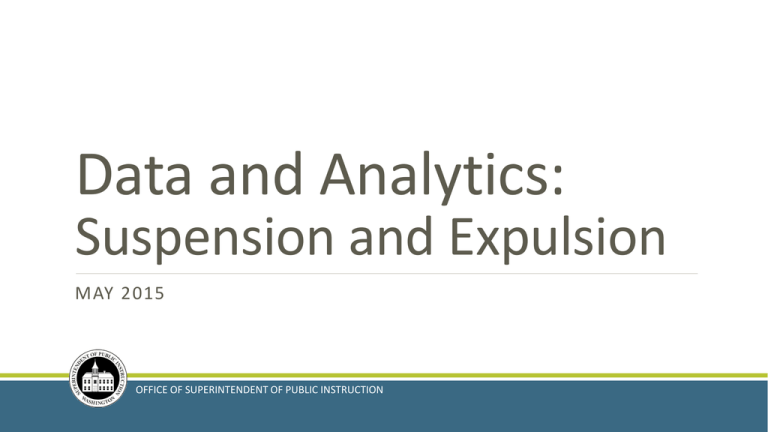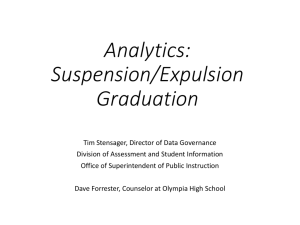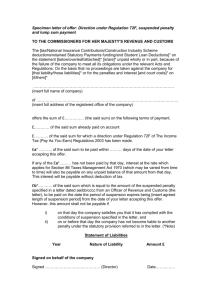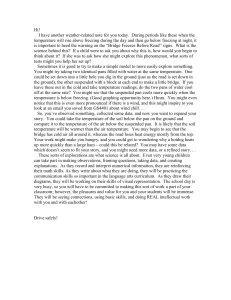Data and Analytics - Office of Superintendent of Public Instruction
advertisement

Data and Analytics: Suspension and Expulsion MAY 2015 OFFICE OF SUPERINTENDENT OF PUBLIC INSTRUCTION Student Discipline: Understanding the Context How many students are suspended or expelled? Who is suspended or expelled? How many times are they suspended or expelled? How long are they removed? For which behaviors? How many students are suspended or expelled? Approximately 4% of all Washington students were suspended or expelled during the 2014–15 school year. The rate of suspensions and expulsions across districts vary—from nearly 0% to over 10% of students in a district. An example: Suspension / Expulsion Rate 100 students in the district 20 were suspended one or more times Suspension Rate 20 students suspended 100 total students = 20% Student Discipline: Understanding the Context How many students are suspended or expelled? Who is suspended or expelled? How many times are they suspended or expelled? How long are they removed? For what behaviors? Who is suspended or expelled? According to state and national data, in many schools, male students, students of color, and students with disabilities are suspended and expelled more frequently than other students. These trends warrant serious attention from schools, as well as OSPI, to work toward equitable outcomes for each student. Schools must carefully review their student discipline data to consider whether policies, procedures, or practices are discriminatory, or have a discriminatory effect, and to remedy them. Are we giving each student an equal chance to succeed? DRAFT Federal Civil Rights Laws Title VI of the Civil Rights Act of 1964 Title IX of the Education Amendments of 1972 Section 504 of the Rehabilitation Act of 1973 DRAFT Federal Civil Rights Laws U.S. Department of Education Office for Civil Rights (OCR) U.S. Department of Justice Civil Rights Division www2.ed.gov/ocr www.justice.gov/crt DRAFT State Civil Rights Law Equal Educational Opportunity Laws • Chapter 28A.640 and 28A.642 RCW • Chapter 392-190 WAC • OSPI Civil Rights Guidelines DRAFT State Civil Rights Law Each district and charter school must annually review discipline data disaggregated by sex, race, ELL-status, and disability (special education and Section 504) to identify and address disparities. WAC 392-190-048 DRAFT Student discipline can result in unlawful discrimination in two ways Dear Colleague Letter, January 8, 2014 (U.S. Departments of Education and Justice) http://www2.ed.gov/about/offices/list/ocr/l etters/colleague-201401-title-vi.html When a school disciplines a student differently based on their protected class (e.g., race, color, national origin, sex, disability) When a school policy, procedure, or practice is neutral on its face, and administered in an evenhanded manner, but has an adverse impact on students of a protected class 1. Has a discipline policy, procedure, or practice resulted in an adverse impact on students of one protected class? 2. Is the policy, procedure, or practice necessary to meet an important educational goal? 3. Are there comparably effective alternative policies, procedures, or practices that would meet the educational goal with less of an adverse impact? Measuring Disproportionality Data analysis into the impact of discipline policies, procedures, and practices is an important indicator of equity and civil rights compliance DRAFT Measuring Disproportionality: Composition Index There are many ways to estimate disproportionality in discipline. One way is the composition index. The composition index measures whether groups of students are suspended or expelled at a rate proportionate to their representation in the student population. In other words, the composition index shows how equitable or representative the discipline rate is for students of a given group. Measuring Disproportionality: Composition Index % of suspensions % of enrollment # of suspended students in group Total # of students in group Total # of suspended students Total # of students An example: Suspension / Expulsion Rate 100 students in the district 20 were suspended one or more times Suspension Rate 20 students suspended 100 total students = 20% An example: Enrollment Overview 100 students in the district 40% are boys 60% are girls An example: Proportionality—Using Composition Index 100 students in the district 40% are boys S S S S S S S S S S S S S S S Composition Index Boys are 80% of suspensions Boys are 40% of student enrollment =2 S S S S S 80% of suspensions are boys S The percentage of suspensions who are boys is 2 times greater than their percentage in the student population. Measuring Disproportionality: Composition Index The closer the composition index is to one, the more proportionate the discipline rate is for that specific group. Numbers greater than one indicate the group makes up more of the suspensions/expulsions than their representation in the population generally. What do these data show? How many students are suspended or expelled? Who is suspended or expelled? What is not shown with these data? How many students are suspended or expelled? Who is suspended or expelled? How many times are students suspended or expelled? How long are they removed? For which behaviors? Districts with fewer than 500 students, or 20 in a given group Let’s visualize it… DRAFT DRAFT Let’s visualize it… District District Z District Z Group Blue Yellow Total Total Students Percent of Percent of Overall Total Student Students with SS, LS, Enrolled Suspended Composition Discipline Enrollment in Group EX Students Students Index Rate 16 4 1 25 33 1.32 18.75 16 12 2 75 67 0.89 18.75 Viewing the districts… The bubbles…. Hovering on a bubble will show… • District name • Composition index of the student group selected • Discipline rate of all students in the district • Percent of the student group within the total student population (the bubble size indicates this percentage) • School year The axis scale…. In this view, the difference between the index for District F12 and A1 for Black/African American is about 1.5. Notice how the axis scale changes when you view Hispanic/Latino. (~1.5) (~0.8) The difference between the index for District F2 and B11 for Hispanic/Latino is about 0.8— yet the space between the bubbles is relatively similar to the chart above. However, if the axis scale is kept the same, it is harder see the statistical difference—the bubbles may end up more condensed and may overlap. On the OSPI discipline charts, the axis scale will adjust. So, be sure to note the axis values! By using filters, select the range of the composition index And/or select the group to analyze And/or select the discipline rate Change the range of composition And/or change the group And/or change the discipline rate DRAFT Act Plan Study Do www.k12.wa.us/studentdiscipline/Equity/default.aspx 1. Plan: Analyze your data and identify root causes Act Plan Study Do 2. Do: Decide on a plan and implement Act Plan Study Do 3. Study: Evaluate and monitor progress Act Plan Check Do 4. Act: Adjust, if necessary Act Plan Study Do Where do I go for help? www.k12.wa.us/studentdiscipline/Equity/default.aspx Equity and Civil Rights Office Office of Superintendent of Public Instruction (360) 725-6162 │ TTY: (360) 664-3631 equity@k12.wa.us





